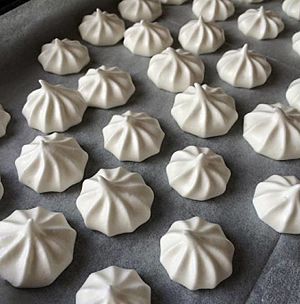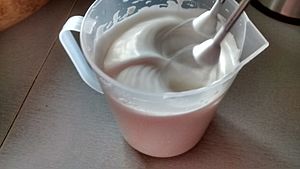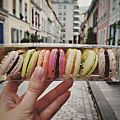Aquafaba facts for kids

Aquafaba (/ˌɑːkwəˈfɑːbə/) is the viscous water in which legume seeds such as chickpeas have been cooked.
Due to its ability to mimic functional properties of egg whites in cooking, aquafaba can be used as a direct replacement for them in some cases, including meringues and marshmallows. It is especially suitable for use by people who avoid eggs, such as vegans.
Etymology
The word aquafaba is from the Latin aqua (water) and faba (bean).
Origins
In December 2014, musician Joël Roessel found that water from canned beans can form foams much like protein isolates and flax mucilage do. Roessel shared his experiments on a blog and published recipes for floating island of Chaville, chocolate mousse, and meringue made from chickpea liquid to demonstrate its foaming capabilities.
Around the same time, vegan food enthusiast Goose Wohlt discovered that the cooking liquid can replace egg white without the need for stabilizers. In March 2015 he published a recipe for egg-free meringue using only chickpea liquid and sugar.
A few days later, a Facebook group was created to encourage development and popularize the egg substitute.
Uses
Aquafaba is used as a replacement for eggs and egg white. Its composition of carbohydrates, proteins, and other soluble plant solids which have migrated from the seeds to the water during cooking gives it a wide spectrum of emulsifying, foaming, binding, gelatinizing and thickening properties.
In general one medium egg white can be replaced with 30 millilitres (2 tablespoons) of aquafaba, or one medium whole egg with 45 ml (3 tbsp).
The simplest way to obtain aquafaba is to decant the liquid from canned or boxed legumes such as white beans or chickpeas. It also can be made by boiling, steaming, pressure cooking, or microwaving pulses in water.
Sweet applications for aquafaba include meringues, macarons, nougat, icing, ice cream, fudge, and marshmallows. Savory applications include baked goods, dairy substitutes, mayonnaise, cheese substitutes, batters, and meat substitutes. Aquafaba is also recommended as a vegan substitute for egg white in preparing cocktails with a foamy "head", particularly sour cocktails like the whiskey sour.
Aquafaba contains about one tenth of the protein of egg whites by weight. The difference in protein content may enable those who cannot properly metabolize proteins (such as phenylketonuria) to consume foods which are normally egg-based. The lower protein content makes it unsuitable for applications which rely on egg protein for structure, such as angel food cakes.
The best aquafaba appears to be from chickpeas and white beans such as the Navy bean. Other legumes such as peas, lentils, soy, kidney, and black beans can be used but their slightly different compositions may require more tinkering with the concentration to work well.
Composition
Legume seeds, or pulses, are primarily composed of carbohydrates (starch, sugars, and fiber), proteins (albumins and globulins), and water. The carbohydrates are found in greater quantities than the proteins; the starches consist mostly of amylose and amylopectin. A typical nutritional composition of chickpeas, is listed as 19% protein, 61% carbohydrate, 6% lipids, and 14% water. However, these amounts are approximate and can vary by variety. During the process of cooking legume seeds, the starches in the seed are gelatinized, allowing the soluble parts of the seed to leach out into the cooking water. More material can be extracted from the seeds, if both the cooking temperature and pressure are increased, as well as extending the cooking period.
Once the legumes are cooked and filtered out, the water-soluble part left is aquafaba. Comparing the final composition of a cooked seed with a raw seed shows that under normal cooking conditions, approximately 5% of the initial dry weight has been transferred to the cooking water. The dry matter consisted mainly of carbohydrates (sugars, soluble and insoluble fibre) and protein. That ratio of soluble material is approximately the same ratio as found in the raw seed. However, fat and starch were not detected. A concentration of 5% dry weight to water is typical for aquafaba, but the solution can also be reduced to increase the concentration to 10% or more, depending on the application. This can be especially useful for applications where emulsification and viscosity are more important than foaming capabilities. The concentration can also be tailored to produce a more stable foam using less aquafaba by carefully filtering non-soluble material from the solution and adjusting the concentration to the application.
In general, the composition of aquafaba depend on: 1. processing methods (soaking, cooking and industrial dehydration), 2. conditions (pH, temperature, pressure and treatment duration), 3. genotype (Kabuli or Desi chickpeas), 4. additives, 5. protein concentration, and 6. carbohydrate type and concentration.
Gallery
See also
 In Spanish: Aquafaba para niños
In Spanish: Aquafaba para niños





